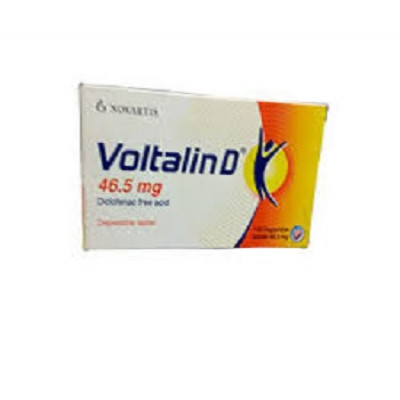Subtotal: ৳ 985.00
Voltalin D (Tab) 46.5 mg
৳ 8.00
Indications
Diclofenac Sodium is indicated in-
- The relief of pain and inflammation in rheumatoid arthritis, osteoarthritis, ankylosing spondylitis
- Non-articular rheumatism, acute musculoskeletal disorders and back pain
- Painful syndromes of the vertebral column
- Acute gout
- Painful post-traumatic and post operative inflammation and swelling such as dental or orthopedic surgery.
- Painful inflammatory conditions in gynaecology and primary dysmenorrhoea.
- In fever and pain associated with inflammatory infections of the upper respiratory tract.
Therapeutic Class
Drugs for Osteoarthritis, Drugs used for Rheumatoid Arthritis, Non-steroidal Anti-inflammatory Drugs (NSAIDs)
Pharmacology
Diclofenac Sodium is a potent non-steroidal anti-inflammatory drug (NSAID) with pronounced anti-rheumatic, anti-inflammatory, analgesic and antipyretic properties. It has also some uricosuric effect. Diclofenac exerts its effect by inhibiting prostaglandin biosynthesis which plays a major role in causing inflammation, pain and fever. Diclofenac is rapidly and completely absorbed from the gastro-intestinal tract when taken with or after meal. Peak plasma concentrations are reached within an average of 2 hours after ingestion of it. At therapeutic concentrations, it is 99.7% bound to plasma proteins. Diclofenac is metabolized in the liver and undergoes first-pass metabolism.
Dosage & Administration
Tablet/Suppository/Gel:
Adults:
Adults:
- Enteric coated tablet: A total of 75-150 mg daily given in two or three divided doses.
- Sustained release tablets: One tablet daily, taken whole with liquid, preferably during meal.
- Suppositories: 75-150 mg daily in divided doses.
- Gel: Depending on the painful site to be treated, 2-4 g gel may be applied 3-4 times daily.
Children:
- Enteric coated tablet: 1-3 mg/kg per day in divided doses.
- Sustained release tablets: Not recommended.
- Suppositories: 1-3 mg/kg body weight in divided doses.
Injection:
Adults:
- One ampoule once (or in severe cases, twice) daily by intramuscular injection.
- Renal colic: One ampoule once daily intramuscularly. A further ampoule may be administered after 30 minutes, if necessary. The recommended maximum daily dose of diclofenac is 150 mg, by any route. The recommended maximum daily dose of lidocaine is 200 mg.
Children:
- In juvenile chronic arthritis, 1-3 mg of diclofenac/kg body wt. daily in divided doses.
- Elderly patients: In elderly or debilitated patients, the lowest effective dosage is recommended, commensurate with age and physical status.
Interaction
Various non-steroidal anti-inflammatory agents are liable to inhibit the activity of diuretics. Concomitant treatment with potassium sparing diuretics may be associated with increased serum potassium levels, making it necessary to monitor these levels. Patients taking Diclofenac and also receiving digoxin, methotrexate, cyclosporine or lithium should be observed for potential development of the specific toxicities of these drugs. Concomitant administration of other systemic non-steroidal anti-inflammatory agents or glucocorticoids may increase the occurrence of side effects e.g. gastrointestinal bleeding.
Contraindications
It is contraindicated in known hypersensitivity to Diclofenac or other non-steroidal anti-inflammatory drugs to patients with active peptic ulcer and to patients in whom aspirin induced asthma, acute rhinitis and urticaria were observed.
Side Effects
Generally, it is well tolerated. The common side effects include- gastro-intestinal discomfort, bleeding, nausea, vomiting, dizziness, headache, jaundice, insomnia, drowsiness, depression, anxiety, urticaria, hypersensitivity reactions (bronchospasm, angioneuratic edema, rashes) and hearing disturbances such as tinnitus.
Pregnancy & Lactation
The use of Diclofenac should be avoided in pregnancy and lactation unless the potential benefits to the other outweigh the possible risks to the fetus.
Precautions & Warnings
It should be used cautiously in patients with a history of cardiovascular disease, in patients with a history of gastro-intestinal disease or bleeding and in patients with severe hepatic or renal damage, asthma etc.
Storage Conditions
Keep in a dry place away from light and heat. Keep out of the reach of children.

 Clean & Clear Foaming Face Wash | 50ml
Clean & Clear Foaming Face Wash | 50ml  Closeup | 100 g
Closeup | 100 g  Carex Classic Condoms | 3 pieces
Carex Classic Condoms | 3 pieces  Clean & Clear Foaming Face Wash 100ml
Clean & Clear Foaming Face Wash 100ml 


Reviews
There are no reviews yet.